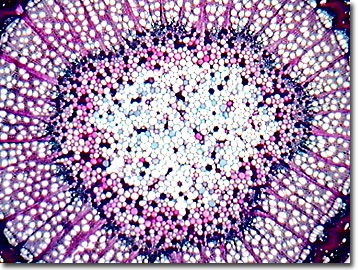Brightfield Digital Image Gallery
Sycamore Stem Cross Section
The American sycamore (Platanus occidentalis; often referred to as the buttonwood or American planetree) is a hardwood tree found primarily in the eastern United States and Canada. Average height of the American sycamore is between 130 and 165 feet, and trunk diameter reaches a maximum of 10 feet. The sapwood is whitish to light yellow or reddish brown in color, while the heartwood is light to dark brown or red in color, but is sometimes difficult to distinguish.

View a low magnification image of the sycamore stem cross section.
View a high magnification image of the sycamore stem cross section.
Distinguishing characteristics of P. occidentalis include a diffuse and porous wood having simple perforation plates and terminal parenchyma. The rays are unstoried, homogeneous, and uniseriate. Vessels are numerous with inter-vessel pits being oval to orbicular and widely spaced. Fiber tracheids are moderately thick-walled and medium to very coarse in texture. Fungi species may attack the branch and stems of the sycamore, forming notable cankers. The American sycamore is also highly susceptible to gray squirrel damage, resulting in crown dieback, lower growth rates, and poor stem quality.
This North American native hardwood tree is a long-lived species with lifetimes often exceeding 500 years, although many trees become hollow after 200 to 300 years. The species easily propagates asexually by cuttings, and naturally, by airborne seed. Optimal growth conditions are cool, deep alluvial soils, and the tree will not adapt to acidic or marshy soils. Sycamore wood is generally either quartered or flat-sawn and is widely used as a veneer for fruit and vegetable baskets, and for indoor paneling. Other uses include sugar and flour barrels, cigar boxes, crates, pallets, furniture, and firewood. Older trees provide valuable wildlife cover, particularly for cavity-dwellers such as woodpeckers, owls, and raccoons, and for humans, much appreciated shade and aesthetic benefits, particularly in urban settings. Along riparian areas, often the bright white inner bark of the tree trunks is visible for long distances and is characteristic of older specimens that have shed their outer layers of gray and brown bark.
Contributing Authors
Cynthia D. Kelly, Thomas J. Fellers and Michael W. Davidson - National High Magnetic Field Laboratory, 1800 East Paul Dirac Dr., The Florida State University, Tallahassee, Florida, 32310.
BACK TO THE BRIGHTFIELD IMAGE GALLERY
BACK TO THE DIGITAL IMAGE GALLERIES
Questions or comments? Send us an email.
© 1995-2022 by Michael W. Davidson and The Florida State University. All Rights Reserved. No images, graphics, software, scripts, or applets may be reproduced or used in any manner without permission from the copyright holders. Use of this website means you agree to all of the Legal Terms and Conditions set forth by the owners.
This website is maintained by our
Graphics & Web Programming Team
in collaboration with Optical Microscopy at the
National High Magnetic Field Laboratory.
Last Modification Friday, Nov 13, 2015 at 02:19 PM
Access Count Since September 17, 2002: 7778
Visit the website of our partner in introductory microscopy education:
|
|
